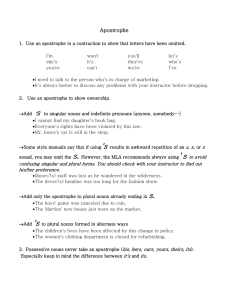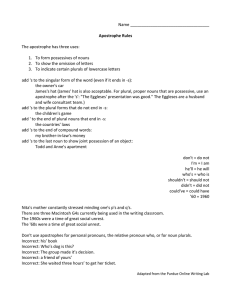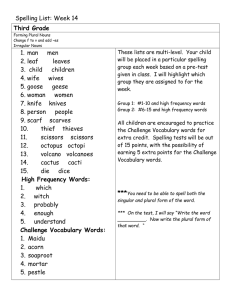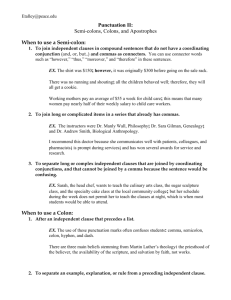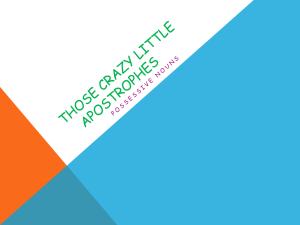Similes well used in character descriptions but less frequently used... this feature
advertisement
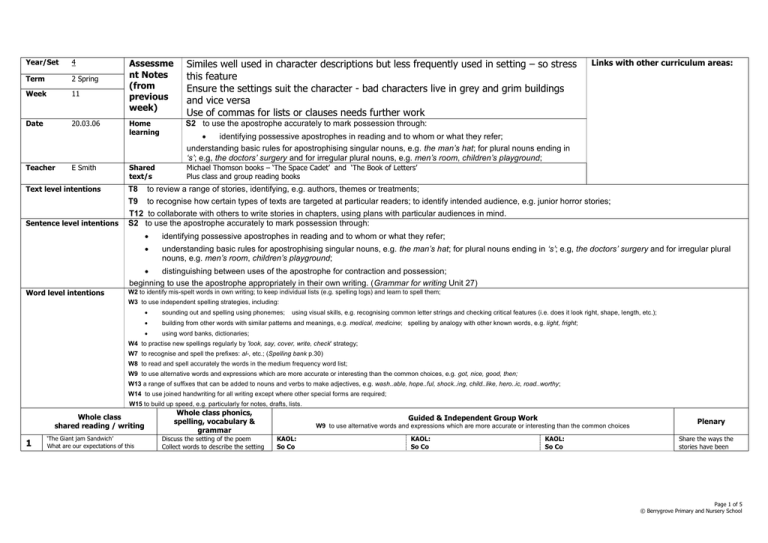
Year/Set 4 Term 2 Spring Week 11 Date 20.03.06 Teacher E Smith Text level intentions Sentence level intentions Assessme nt Notes (from previous week) Similes well used in character descriptions but less frequently used in setting – so stress this feature Ensure the settings suit the character - bad characters live in grey and grim buildings and vice versa Use of commas for lists or clauses needs further work Home learning S2 to use the apostrophe accurately to mark possession through: Shared text/s Michael Thomson books – ‘The Space Cadet’ and ‘The Book of Letters’ Plus class and group reading books Links with other curriculum areas: identifying possessive apostrophes in reading and to whom or what they refer; understanding basic rules for apostrophising singular nouns, e.g. the man’s hat; for plural nouns ending in ‘s’; e.g, the doctors’ surgery and for irregular plural nouns, e.g. men’s room, children’s playground; T8 to review a range of stories, identifying, e.g. authors, themes or treatments; T9 to recognise how certain types of texts are targeted at particular readers; to identify intended audience, e.g. junior horror stories; T12 to collaborate with others to write stories in chapters, using plans with particular audiences in mind. S2 to use the apostrophe accurately to mark possession through: identifying possessive apostrophes in reading and to whom or what they refer; understanding basic rules for apostrophising singular nouns, e.g. the man’s hat; for plural nouns ending in ‘s’; e.g, the doctors’ surgery and for irregular plural nouns, e.g. men’s room, children’s playground; distinguishing between uses of the apostrophe for contraction and possession; beginning to use the apostrophe appropriately in their own writing. (Grammar for writing Unit 27) Word level intentions W2 to identify mis-spelt words in own writing; to keep individual lists (e.g. spelling logs) and learn to spell them; W3 to use independent spelling strategies, including: sounding out and spelling using phonemes; building from other words with similar patterns and meanings, e.g. medical, medicine; spelling by analogy with other known words, e.g. light, fright; using word banks, dictionaries; using visual skills, e.g. recognising common letter strings and checking critical features (i.e. does it look right, shape, length, etc.); W4 to practise new spellings regularly by 'look, say, cover, write, check' strategy; W7 to recognise and spell the prefixes: al-, etc.; (Spelling bank p.30) W8 to read and spell accurately the words in the medium frequency word list; W9 to use alternative words and expressions which are more accurate or interesting than the common choices, e.g. got, nice, good, then; W13 a range of suffixes that can be added to nouns and verbs to make adjectives, e.g. wash..able, hope..ful, shock..ing, child..like, hero..ic, road..worthy; W14 to use joined handwriting for all writing except where other special forms are required; W15 to build up speed, e.g. particularly for notes, drafts, lists. Whole class shared reading / writing 1 ‘The Giant jam Sandwich’ What are our expectations of this Whole class phonics, spelling, vocabulary & grammar Discuss the setting of the poem Collect words to describe the setting Guided & Independent Group Work W9 to use alternative words and expressions which are more accurate or interesting than the common choices KAOL: So Co KAOL: So Co KAOL: So Co Plenary Share the ways the stories have been Page 1 of 5 © Berrygrove Primary and Nursery School 2 3 4 5 story/poem based on the title. Discuss the book – what age group do they believe the story is aimed at based on the cover, blurb etc T9 to recognise how certain types of texts are targeted at particular readers; to identify intended audience – the village before the wasps arrive after the wasps arrive Would you use different adjectives once the danger arrived? The Space Cadet Select stories designed for children where multiple options are available at the end of each section. Discuss who these books are aimed at and their popularity. T8 to review a range of stories, identifying, e.g. authors, themes or treatments; Show another example of the multiple choice options books. Ask the children to predict what the text inside looks like. Discuss life choices. Drama activities in groups 6 basic cards ‘The walk to school’ as each thing is met our two characters make choices about what to do – how would the walk to school change if different choices were made? The Space Cadet Continue to read the story designed for children where multiple options are available at the end of each section. T8 to review a range of stories, identifying, e.g. authors, themes or treatments; Space Fleet Continue to read the story designed for children where multiple options are available at the end of each section. T8 to review a range of stories, identifying, e.g. authors, themes or treatments; LIBRARY VISIT DAY T9 to recognise how certain types of texts are targeted at particular readers; to identify intended audience, e.g. junior horror stories; Research the books in the library. Find collections of books aimed a particular audiences – publishers logos etc MAIN TASK A small change in the title changes your expectation of the story – now how should our new story end? Working collaboratively as pairs – Discuss the way they want the story to end to tie up all loose ends – sandwich, giant and village KAOL: So Co En Re MAIN TASK Use of apostrophes S2 to use the apostrophe accurately to mark possession through: understanding basic rules for apostrophising singular nouns, e.g. the man’s hat; for plural nouns ending in ‘s’; e.g, the doctors’ surgery and for irregular plural nouns, e.g. men’s room, children’s playground; distinguishing between uses of the apostrophe for contraction and possession; SUPPORTED TASK Discuss with OA discuss each page and how it would be written if it were not a poem and it was a giant that the sandwich was being made for. Adult to scribe and children to illustrate. How would they draw the new story to a conclusion? KAOL: So Co En Re SUPPORTED TASK Using the apostrophe for contraction Give the groups the large table sized mat/map for the story and the cut out characters. Discuss the key elements and the possible endings story making cards. Review the fact that they are not and must not write the whole story – this is one or two possible events from the story to write on cards. Review the punctuation which was not desirable from yesterday. Consider the use of full stops and capital letters plus commas for KAOL: So Co STORY WRITING aim or two events in each writing session Upon leaving the house the children could go north (left) away from school – where might this lead and why go there Examine the out side of books and blurbs for evidence of the audience the books were written for. Does the content of the text support this? Look for vocabulary which is unfamiliar in books aimed at younger readers in the fiction section – does this happen? KAOL: So Co En Re MAIN TASK KAOL: So Co Continue story writing select one of the events cards not already used on the table and continue the story W9 to use alternative words and expressions which are more accurate etc Using the collaborative learning resource on adjectives EXTENSION TASK Working in a larger group 4’s agree and collaborate on the story ending having reached an agreement on their ending record the ending individually in books ended. Which endings drew together all the loose ends from the re-worked story? KAOL: So Co En Re EXTENSION TASK Using the more challenging sheet including irregular nouns and distinguishing between the uses of apostrophes. Children look through their reading books looking for apostrophes then share some examples of the apostrophe in action. KAOL: So Co STORY WRITING supported group could dictate their ideas and be supported in the production of the writing Upon leaving the house the children could go north (left) away from school – where might this lead and why go there KAOL: KAOL: So Co STORY WRITING extension group to consider their use of adjectives and adverbs as well as the punctuation requriements Upon leaving the house the children could go south (right) towards the school – where might this lead and why go there KAOL: Share some of the story starts and discuss what might happen next in their story. Continue story writing select one of the events cards not already used on the table and continue the story Continue story writing select one of the events cards not already used on the table and continue the story KAOL: So Co En Re SUPPORTED TASK Use the KS1 Connect 4 task work with OA KAOL: So Co En Re EXTENSION TASK Work independently without adult support to collaboratively improve the words in the connect 4 grid. http://www.primaryresources.co.uk/online/ apostrophes/index.html Share the next parts of the story. Did anyone take their characters somewhere unexpected? Discuss the adjective improvements and how easy it is to work collaboratively. Page 2 of 5 © Berrygrove Primary and Nursery School 6 The Book of Letters Continue to read the story designed for children where multiple options are available at the end of each section. T8 to review a range of stories, identifying, e.g. authors, themes or treatments; What did you notice about ‘The Book of Letters’? Why would a book be written this way? Could we write an apostrophes page? The apostrophes rule? What should it say? KAOL: So Co KAOL: So Co KAOL: So Co Continue story writing select one of the events cards not already used on the table and continue the story Continue story writing select one of the events cards not already used on the table and continue the story Continue story writing select one of the events cards not already used on the table and continue the story COMPREHENSION DAY Discuss answering questions fully Display the simple paragraph and discuss questions which could be asked about it and how the answers could be written KAOL: So Co KAOL: So Co KAOL: So Co MAIN TASK Focus on Comprehension Comprehension Book 1 UNIT 18 Hot Dog Harris SUPPORTED TASK Focus On Writing Composition Starter Unit 2 Patterns in Stories Layla’s bike EXTENSION TASK Focus on Comprehension Comprehension Book 2 UNIT 8 Tim the Trumpet Discuss the concept of treatment of the content in the books by Michael Thomson Show and discuss the sheet on themes – review the book being read as class or groups identifying other books by this author the treatment of the subject and the themes which can be found MAIN TASK Read as class or groups Independently or supervised Expect the groups to be able to discuss the themes independently 7 GROUP READING DAY 8 T8 to review a range of stories, identifying, e.g. authors, themes or treatments; Share the stories now they are finished and the reasons why multiple choice stories are popular with early readers Share the comprehension answers and discuss what kind of stories each were and any aspects of theme or subject treatment they had discovered. Discuss how the discussions had gone – Popular authors and their treatment of subjects or themes inside the stories. Page 3 of 5 © Berrygrove Primary and Nursery School T8 T9 to review a range of stories, identifying, e.g. authors, themes or treatments; to recognise how certain types of texts are targeted at particular readers; to identify intended audience, e.g. junior horror stories; Theme What does the story mean to you? Does the author have a big idea or message to share? Is the theme of this book similar to themes in other stories you’ve read? Tell about them. What have you learned from reading this story? What does the story make you think about? How does it relate to your life and experiences? Does it help you understand anything about the world you live in? How will you know if your group has been successful in Group Reading Time? You will have read together co-operatively. Used a variety of strategies to solve unfamiliar words – and logged the words in your reading journal. Discussed the theme saying what the story means to you, if the author is sharing a big idea or hoping you will get a particular message. You should also talk about other books you have read that had this kind of theme and how it relates to your life and experiences andPage 4 of 5 © Berrygrove Primary and Nursery School your understanding of the world. 2A 2B David and Amy left the house and turned left David and Amy left the house and turned right 3A WALKED TO THE PARK ON THE WAY TO SCHOOL 4A BEGAN TO PLAY AND FORGOT THE TIME 3B WALKED TO THE ALLEY TO TAKE A SHORT CUT 3C WERE WALKING 3D ALONG WHEN THEY SAW WERE WALKING WHEN A MAN WITH A DOG THEY NOTICED THEY HAD FORGOT TEN THEIR HOMEWORK 4B 4C 4D 4E 4F 4G 4H LOOKED WALKED COULD WERE WENT TO DECIDED DECIDED OVER QUICKLY HEAR A WORRIED STROKE THE TO GO NOT TO GO THE HILL BESIDE SOUND BY THE DOG AND….. BACK TO BACK FOR AND THE BEHIND DOG GET THE THE SAW… WALL…. THEM AS ………….. HOMEWOR HOMEWOR THEY… K BUT….. K AND 5P Walked to school inventing different reasons why they hadn’t remembered their homework 5O Didn’t want to be late for school but walked on safely to school 5N Their Mum was surprised to see them back and decided she would……. 5M When they got back to the house they found that no-one was there so … 5L Were worried about being late for school so didn’t ……………. 5K Spent a long time stroking the dog and didn’t realise how much time had passed so ……………….. 5J Were worried by the dog but the helpful owner …………… 5I Were so frightened by the dog and its owner that they ran ………. 5H Were suddenly grabbed by ………….. 5G Looked behind to see who or what it was then rushed ……….. 5F Decided to climb over the wall to …….. 5E Left the alley and went quickly to school through the underpass ……….. 5D Were attacked by the park trolls and were ……………… 5 C Reacted to the thing they saw and went to tell ………….. 5B Decided to stay in the park and play until home time doing…………… 5A Rushed to get to school on time crossing the stream by the bridge T12 to collaborate with others to write stories in chapters, using plans with particular audiences in mind. This is the plan which shows where the story is going. Your job is to write about each part of David and Amy’s possible adventure. You will know if you have done a good job if you have: 1. Described the characters and settings 2. Used good punctuation . , and “ …….” 3. Included at least one simile Page 5 of 5 © Berrygrove Primary and Nursery School
